Karen Commins's Blog, page 4
February 24, 2021
Ongoing Masterclasses and Acting Classes
I think it’s safe to say that every professional, no matter the occupation, constantly undertakes training to improve their subject matter knowledge and learn new ways of doing things.
When I worked my first career in information technology, I had to stay current on software and hardware releases and understand how each component could affect the overall operation. In addition to taking specialized classes from vendors, I continuously read forums and magazines devoted to technology.
I would also experiment with new software in a lab environment. The worst thing we could do was install unproven software on our live system and then deal with the fallout from unhappy/downright angry system users who were thwarted from completing their tasks, or worse, lost work due to our changes.
While my job as a narrator doesn’t immediately affect other people, I still prefer to get training and experiment with my narration in a safe space.
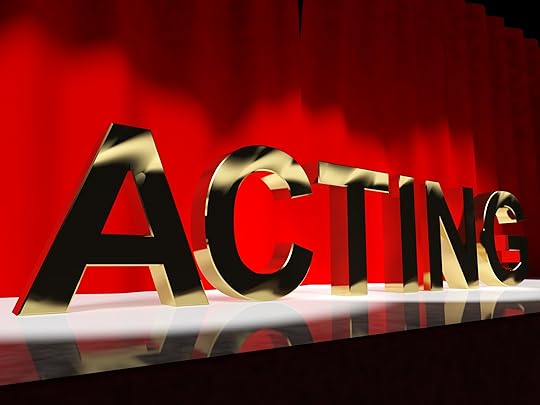
Last fall, I undertook 6 masterclasses from the Deyan Institute. Narrator PJ Ochlan hosted guest casting directors Jesse Bickford (Blackstone Audio), Gabrielle de Cuir (Skyboat Media), Guy Oldfield (Macmillan Audio), Caitlin Garing (Harper Audio), Khai Dattoli (Deyan Audio), and Linda Korn (Penguin Random House Audio) in separate 3-hour sessions in which 20 narrators performed a passage of our choosing.
Prior to 2020, I’d only been able to attend one of these masterclasses because they necessitated a trip to LA. With COVID-19 causing everyone to stay home, I was thrilled when I saw these classes would be offered over Zoom.
In each session, the industry director and PJ would give us guidance about ways to make our read better. We’d try a take 2 and sometimes 1 or more additional takes to incorporate their direction. With the slightest changes, a read can go from serviceable to superb.
They would point out areas in the text that were rich with clues about the underlying subtext that could lead to more nuanced acting choices. I can’t overstate the importance of developing the skill of taking the notes given to you and doing something that expresses you understood and are incorporating the direction into your read.
Each director had a different style, but all tried to help us approach the text more authentically — in other words, to be able to present the scenes as though they were really happening to us. Not only did we improve our performances, but listening to the feedback given to others proved highly valuable.
For instance, when thinking about your listening audience, it’s more helpful to envisage the exact type of person who would want to listen to THIS book instead of a general person close to you.
I’ve signed up for 4 more masterclasses over the next 2 months and am looking forward to the first one this Thursday with Iris McElroy (Harper Audio).
Acting for AudioMeanwhile, I’m in my 6th week of Joel Froomkin’s Acting for Audio 14-week intensive course. Outside of a 10th grade speech class, I’ve never had an acting course. I’ve heard and read about many of the topics we’re discussing each week and enjoy seeing how they apply to acting in front of a microphone.
Only 10 narrators are in each section of the 3-hour classes to give us time for our performances and Joel’s lecture.
We have to plan and practice a short scene each week to meet certain criteria. Even though we normally work off camera in the booth, doing these tasks on camera helps fire the imagination to better visualize scenes and add physicality as we narrate.
Knowing that I’ll be performing over Zoom means I have to decide what to present, work through the logistics of doing it for an online audience, and practice a number of times before I’m ready to go live for the class.
Many of the exercises have come with a written assignment. In answering the questions, I’ve been surprised at some of the things I’ve never considered and learned about myself.
In both the masterclasses and the acting class, it’s been very interesting to observe the performances. Even without the text in front of us or knowledge of the scene beforehand, we can tell when the narrator wasn’t being true to the emotion of the scene or was otherwise unconvincing, like when an attitude crept into a character voice that didn’t match the author’s intent.
As we immerse ourselves in the characters and story during our narrations, we must allow ourself time to make the discoveries and feel the emotions as the characters would in that moment.
If a director and other colleagues can detect a narrator’s disconnection during these classes, our listeners likely will also hear it in our audiobooks.
I think of the Deyan masterclasses like an appetizer and Joel’s classes like Thanksgiving dinner. I don’t want to give too many specifics about each because doing so wouldn’t be fair to my colleagues who paid for these experiences.
I’m grateful these wonderful instructors have held these classes online and know that my narration skills have improved with each one. I highly recommend both the Deyan Masterclasses and Joel Froomkin’s Acting for Audio course for audiobook narrators who want to take their intepretation and acting skills to a higher level.
The post Ongoing Masterclasses and Acting Classes appeared first on Karen Commins.
February 20, 2021
5 Things I Learned From Margaret Mitchell’s Letters
I always wondered why Margaret Mitchell didn’t write another novel after Gone with the Wind. I thought she could have feared the critics’ comments as they compared a second book to the epic, monumental achievement of her first. Nothing could ever live up to the reputation of her Great American novel.
However, when I narrated Road to Tara: The Life of Margaret Mitchell by Anne Edwards, I learned one big reason for Mitchell’s later absence from the bookshelves of new releases: she was too busy responding to correspondence about her book to write another book!
Embed from Getty Images
I’ve read the 2 books of her letters linked below. I’ve also been collecting the pictures of her letters posted by eBay sellers.
Mitchell published GWTW in June 1936, and it instantly became a runaway bestseller. David O. Selznick then paid the highest price to that date for the movie rights, causing Mitchell’s celebrity to rise even higher.
Suddenly, all the newspapers and magazines wanted to do interviews with the reluctantly-famous author. In numerous letters, she described fans as jumping out of the bushes at her home to get her autograph.
She was so besieged by people who wanted her to sign their books that she stopped signing them after a couple of months. However, she replied to hundreds or maybe thousands of letters requesting an autographed book to explain why she wouldn’t do it — and then signed the letter!
Maybe Mitchell felt compelled to respond to almost everyone due to her inborn sense of graciousness and Southern hospitality. Maybe she secretly thrilled at being a celebrity and sought to keep more recognition coming to her.
Whatever her reasons, she spent all day, every day, immersed in and often overwhelmed by her mail. For instance, she fielded fans’ questions, as well as requests for speaking engagements and material mementos.
Although Mitchell vowed not have any part in making the movie, she answered and wrote a barrage of letters about it. She also kept eagle eyes and a tight rein on the foreign rights and translations of her book, initiating and participating in countless exchanges about those aspects of publishing.
I think of Margaret Mitchell often when I’m reading, replying to, and writing my email and communicating in online forums. I learned a few things from the way she dealt with her voluminous correspondence that I want to share with you.
Use templates, and then liberally copy and paste.Margaret only had her trusty typewriter and reams of paper at her disposal. What might she have achieved and how productive might she have been with a computer? Rather than re-typing the same info to multiple people like she did, we have the luxury of copying and pasting from one message to another.
If you find yourself sending the same message on a recurring basis, create a template for that type of correspondence. For instance, I have a folder in Evernote containing my templates for numerous situations, including:
prospecting emails to publishers and authors (they ARE different!)messages to authors who chose a different narrator from an ACX auditionrequests for reviewsinquiries about licensing rightsasking permission to add people to my mailing listI even have a template for newcomers who leave me voice mail asking to talk with me about becoming a narrator! It’s super fast and easy for me to open my Evernote app on my phone, find that template, and copy and paste it to a text message back to the originating phone number. In the time it took for me to write or you to read that sentence, I could have taken those actions, responded to that query, and moved on with my day.
2. Create and use keyboard text shortcuts.
Facebook Messenger, WordPress, and other platforms don’t maintain my email signature. As pictured below, I set my keyboard text replacement to automatically and magically type Cordially, Karen Commins when I type the 3 letters ckc and press space or return.

I have created a number of text shortcuts for things that I type frequently:
my email addresssign-off sentence in emaildaily tasks like walking my dogmy web site URLsMacOS has text replacement as a built-in feature. From my quick Google search, it looks like you have to use a separate text expander utility in Windows to get this functionality. I saw this one recommended on several sites, and its capabilities go beyond simple text replacement.
3. Don’t answer everybody even when you know the answer.
Mitchell prided herself on the depth and accuracy of her historical research for GWTW. She felt compelled to set the record straight whenever anyone questioned the facts in her book. Instead of defending her previous research, she could have spent that time doing new research for a new project.
This tip is becoming one of my mantras! I remind myself of this point when I am reading Facebook forum threads. I’ve decided it’s not my job or even in my best interest to share my knowledge every time the opportunity presents itself.
In addition, I receive LOTS of messages from narrators, authors, and wannabes via email, text messages, and social media. As I’ve previously noted, if I personally assisted everyone who asked for my help, I would never have time to do any work of my own.
I state on my Contact page:
Due to the volume of requests that I receive, I may not personally respond to your message. I prefer to answer publicly so that more than one person benefits from the answer.
If I can quickly point someone to a blog article or other resource, I am very happy to do so. Otherwise, since I have stated my policy, I feel no guilt when I sometimes need to press the delete key. I especially use the delete key when I know someone wants to sell me something or I can tell that writing a suitable answer would take more than 5-10 minutes. I make a note of questions that require more involved answers for subjects to explore here on the blog.
4. Don’t put others’ needs ahead of your own creative output.
I saw a quote recently that speaks to this thought:
“When you say yes to others, make sure you are not saying no to yourself.”
— Paulo Coelho
When I re-read my journals, I’ve noticed that I’ve said on too many occasions that I didn’t even start on my project for the day because I was helping other people.
Helping people gives me joy. I feel it’s a large part of my purpose.
I’m realizing, though, that I can help more people in the long run by prioritizing my creative projects (like writing this article!) ahead of helping a single person in the moment.
5. Get to the point quickly, and don’t bury the lede.
Mitchell’s letters show her immense strength and charm as a loquacious storyteller. She wrote the most chatty, lengthy letters and would wax on for paragraphs assuming that her recipient was devouring her every word with keen interest.
People today are too busy and get far too many sources of info hammering at us every day.
When I worked as the deputy branch manager in my government IT career, my boss complained that he received lengthy emails that left him wondering what the person wanted him to do. He often forwarded such messages to me to decipher and resolve.
At least once a week now, one of those kinds of messages appears in my inbox. If I can’t quickly figure out what the person wants from me, I delete the message.
A while back, I did some research to learn the ideal length for a prospecting email to a potential client. One writer uses a 5-sentence rule.
The sweet spot falls between 50 and 125 words, which is not much longer than a tweet. I use this site to check the length of emails before I send them.
You also may want to compose messages on your phone because more people are now reading and replying to emails on their phones. If you have to scroll your message, it’s time to make some cuts!
If you wonder why your emails go unanswered, one article writer commented that, like my former boss, s/he felt anxious when seeing large blocks of text. Do they have time to read it? Would they get all of the sender’s points? Do they need to read it carefully? Do they have time to write a long response?
When I’m drafting a message, I may write it in linear/chronological fashion about the situation, which naturally causes my call to action to fall near the end. I then move that action to the 1st or 2nd sentence so it’s immediately clear to the recipient why I sent the message and the action I want them to take. I’ll also enter the action as the subject of the message. I’ll edit the message to use a journalism-style of inverted pyramid where the least important info is left to the end.
Applying these 5 guidelines to my own correspondence and forum participation enables me to spend more quality time on my own projects. How do you make time for your creative work? Please leave a comment!
The post 5 Things I Learned From Margaret Mitchell’s Letters appeared first on Karen Commins.
January 15, 2021
Put Yourself in the ACX Driver’s Seat Webinar

I was reflecting this week about being able to create audiobooks from my studio here in Atlanta for the past 10 years.
To be clear, I’ve recorded all of my audiobooks in my studio. However, when I started narrating early in the millennium, most publishers didn’t want to hire home studio narrators.
I always said I could fly any where; Atlanta is the home of Delta Airlines, after all. The answer was always “Why should we fly you to NY or LA when we have an abundance of talent nearby?”
Everything changed in 2011 when Audible developed ACX.com, its marketplace for narrators and rights holders to get together to produce audiobooks.
I’ve been there since day 1 when the site was in beta test:
1/12/11 — Audible invited me to a super secret, hush hush conference call.On 1/12/21, I tweeted my journal page from that day.1/14/11 — I was on the call and learned about ACX. Audible asked me to be a beta tester, and I immediately said YES! On 1/14/21, I tweeted a 1:30 video reading from my journal entry that day.5/12/11 — Audible launches ACX to the world.I announced it that day in this blog post .9/18/11 — After submitting 23 auditions on ACX, I won one from a publisher. The book was Dixie Divas , which was the first in a series of 5 books and a bunch more I did for Belle Books, the publisher. Dixie Divas was a royalty share book that has paid several times what my PFH rate would have been and continues to make money for me every month!1/22/14 — The Heart of the New Thought , my first book as a RH, went live.I wrote about it in this blog post .5/15/14 — Part 1 of my article about audiobook marketing appeared on the ACX blog.5/20/14 — Part 2 of my article about audiobook marketing appeared on the ACX blog.4/7/16 — My article How to Act Like an Audiobook Narrator appeared on the ACX blog.11/2/18 — I was the featured guest on ACX University .I wrote about the video and added links in this blog article .Of course, I’ve written MUCH more about ACX here on my blog! I’m also a frequent contributor in narrator Facebook groups, particularly the Indie (ACX and Others) Narrators and Producers Group, where I developed and maintain the extensive group FAQ.
I’ve been delighted each time John Florian at VoiceOverXtra has shared one of my articles with his audience. After republishing one of them recently, John asked me if I’d be interested in doing a webinar about ACX.
I responded to him the same way I did to Audible about beta testing ACX 10 years ago: YES!
I’m thrilled to announce VoiceOverXtra will host my webinar Put Yourself in the ACX Driver’s Seat on 11 February!
You can read about it and sign up at this link. You can get a 10% discount if you sign up by Saturday 16 January.
If you leave questions below, I’ll try to answer them during webinar.
I hope to see you there!
The post Put Yourself in the ACX Driver’s Seat Webinar appeared first on Karen Commins.
January 11, 2021
Commit to Creativity Workshop
Yesterday I attended the Commit to Creativity workshop hosted by Krista Vernoff, show runner for the Grey’s Anatomy TV show and others. After doing 2 writing exercises during the workshop, I feel inspired and energized to write more articles here on my blog.
I’ll discuss the workshop and share those 2 powerful writing prompts in a minute. First, I want to discuss my plans for this blog going forward.
I want to write more frequently, and I want to write shorter pieces sometimes.
I also give myself permission to write more about my own journey as a recording artist, writer, and owner of a membership site. While I’m changing my format and focus somewhat from more substantive content that I’d call “teachable moments” — I will still write those, of course! — I think the lessons I learn and observations I have along the way will still be relevant to other narrators and authors who are publishing their work in audiobooks.
With that said, let me tell you now about the workshop yesterday.
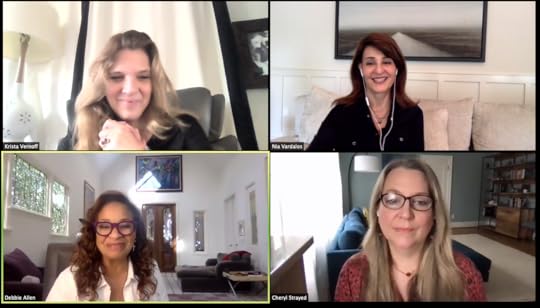
I could say that I only learned about this workshop through accident.
On 29 December 2020, I saw a post in a Facebook group where someone referenced this Twitter thread that wrote about having a life in the arts. I confess that I did not know who she was when I clicked the link.
I connected to what she wrote and saw that she was hosting this workshop. Her guests were actress/director/dancer/choreographer , actress/writer , and author Cheryl Strayed.
I knew the phenomenal accomplishments of these ladies and thought the afternoon would be entertaining, if nothing else. I signed up.
When the event started, I felt excited to be in the presence of these creative powerhouses! Within a few minutes, their genuine natures had crossed the ether in the casual Zoom atmosphere and made me feel like they were mentors and friends I had known for years.
Of course, I took a loooong page of notes in Evernote! Almost every utterance from each of these accomplished women was a golden nugget of wisdom. Listed below are a few of the gems I heard:
The most important thing is to learn how to take a note even if you don’t like it. — Krista VernoffIf the phone doesn’t ring with a job offer, call yourself and do your own project. — Nia VardalosDon’t reject yourself. Don’t let someone else’s opinion or criticism come for you. — Debbie AllenPart of creating art is letting it go. — Cheryl StrayedA Compelling Case Study
One part of the conversation was particularly thrilling to anyone in a creative field as we all can follow similar steps to our own destiny!
Early in her career, Cheryl wrote a series of essays as if she were an advice columnist named Sugar. She wrote them for free to create content for a friend’s web site.
At some point, she repackaged and repurposed those essays into a book named Tiny Beautiful Things: Advice on Love and Life from Dear Sugar.
Some time later, a director urged Nia to read Tiny Beautiful Things. Nia had a highly emotional experience in reading the book; she used the phrase “it unzipped me” to describe it.
Nia decided she wanted to adapt it for a stage play — not that she had any experience in stage adaptations.
She laughed as she said she had the AUDACITY to ask Cheryl Strayed for the permission to develop that adaptation.
Not only did Cheryl say “yes” to the adaptation, but she asked Nia to play Sugar in the stage production! Although Nia hadn’t even given herself permission to ask that question, she had no hesitation in her answer: “Yes, please!”
She and Cheryl lived on opposite coasts, so it cost Nia money to fly back and forth for meetings with Cheryl and later the Broadway production.
In its review of the play, the New York Times awarded a Critics Pick designation.
Nia commented that she’d made the least money on that play than any other professional pursuit, but it gave her the most professional satisfaction.
Now, the play has been done in numerous other cities and theatres. I’m sure when Cheryl wrote all of the columns originally way back when, she never would have dreamed that her creative output would take on the life that it did.
By the way, Nia did an incredible reading from the libretto that had us all in tears. Cheryl’s words and Nia’s interpretation left me breathless and further motivated me to continue improving my acting ability in order to bring even more nuance to my narration.
The Writing Prompts
At the workshop’s conclusion, I no longer thought of this workshop as an “accidental” find. It was more a case of “when the student is ready, the teacher appears.”
You’ll remember that I said Cheryl gave us 2 writing prompts. In writing the second one, I found marching orders to guide my path going forward!
She explained we must trust the clarity of our deepest inner truth. Every day, she has to face down the inner critic and start new. Cheryl said, “Every time you do it, you evolve. You hand yourself the key to your next becoming.”
The writing prompt she gave us was:
Dear [your name here],
This is your deepest inner truth, and here is what I know.
In her prelude to the second prompt, Cheryl stated that your power/strength/love is at the root of your desire. She encouraged us to not think about the obstacles we face, but to instead think how it feels when you have stepped into your power and are creating your art. “Who are you when you are doing what you are most deeply, divinely called to do?”
Here’s the writing prompt:
Dear [your name here],
This is your power, and this is who you are when you own me.
In both cases, you should set a timer for 10 minutes and then write everything that comes to you as fast as you can. Don’t stop to edit or fix mistakes. Just keep writing.
For me, the last 3 sentences I wrote about my power contained truths I knew but had tried to ignore.
I won’t ignore them any more.
If you do these 2 exercises, did you learn something about yourself? I hope you’ll share your comments below!
The post Commit to Creativity Workshop appeared first on Karen Commins.
September 12, 2020
When the Author is 6 Feet Under
I’ve recently helped a number of narrators research the audio rights holder in cases where the author has passed away. I decided to share my process as it might be helpful to other people.

Focus on the Copyright Date
I start by examining the book’s copyright date. Books published in the US before 1925 are already in the public domain. If it falls between 1925 and 1963, I first check to see if the title is in the public domain using the links in this article. (Note: While some of the info below is summarized in the last bullet point on that page, I want to offer more explanation and show the successive steps in this post.)
If I find that the book is in the public domain, I stop my research. The narrator can perform and publish the book on their own without contacting anyone or paying any licensing fees or royalties.
A large percentage of texts from those years appear to be copyrighted but are actually in the public domain due to a key technical requirement of the copyright law at that time. Copyright owners — usually the author, but it could be the publisher — had to renew the copyright by the end of the 28th year following publication in order to maintain their copyrighted status.
These books can be categorized into one of these ways:
Between 1925 and 1977, if the book wasn’t published with a copyright notice — in other words, if it didn’t include the C in the circle © or say the word copyright with a date — it’s in the public domain.
If the book was published between 1925 and 1963 and was published properly with the copyright notice, but the copyright owner didn’t actually renew the copyright, it’s in the public domain.
If they published it with all the correct formalities and renewed it by the end of the 28th year following publication, the copyright was extended for an additional 67 years, or a total of 95 years under copyright. Its copyright runs through the end of the 95th year after the publication date. You would need to continue your research as indicated in the next section.
As an aside, be aware that everything that was published in 1925 is going to be in the public domain on 1 January 2021. Enterprising narrators may want to pay attention to that point because you could start looking for an upcoming public domain book that you want to do! If this topic interests you, I’m creating a course for members of NarratorsRoadmap.com that includes a discussion about how to find some of these public domain gems.
Each January 1st, another year’s books enter the public domain. On 1 January 2022, books published in 1926 enter the public domain, and so on.
Find The Person
For works still under copyright that were traditionally published, you can contact the subsidiary rights department of the publisher.
However, I prefer to find someone representing the author since publishers can take a long time to respond, if they respond at all. You would also need to do this research for books independently published.
I perform a number of Google searches that will seem like word association.
This first search is best for prolific authors or those who wrote 1 or more books that are considered to be classic literature. If you’re lucky, the results will lead you directly to the door of the person who manages the rights.
[author name] literary estate or [author name] literary rights
As an example, doing this search for reclusive author J. D. Salinger will readily show in the results that his work is zealously controlled by his son Matthew. The estate waited until 2019 to allow ebook productions of Salinger’s works and still hasn’t permitted audiobooks to be made.
I usually then search for the author’s obituary.
[author name] obituary
Once I find the obituary, I look for the names of the author’s agent, the publisher, and survivors. If the survivors live in a different city from the author, their city is usually listed in the obituary.
[survivor’s name] [city name]
Sometimes I need to search for a survivor’s name with the author’s name.
[survivor’s name] [author name]
I’ll usually get some hits, possibly including the survivor’s obituary if the book was published decades ago. I once wound up creating a family tree for one famous, early 20th century author!
Sometimes the survivor’s name will pop up on a site with some contact info, or I might see other tidbits that I can add to my search terms, like a business name or organization they are associated with.
If I don’t find those names in the obituary, I will do satellite searches with the author’s name, like
[author name] agent
[author name] manager
The author may have left their papers with a museum or university. If the archivist has created a finding aid for the papers, you may see contact info for the estate, especially if the material is restricted. I’ve also paid an on-site researcher to look through the contracts. I search for finding aids with this format:
[author name] papers finding aid
Find Their Contact Info
Once you’ve determined a promising contact name, you’ll need to find their contact information. If you’re living a charmed life, you might see an email address, web site, and/or phone number listed on one of the pages you’ve already reviewed.
Without that serendipity, you can do some more searches to look for those pieces to the puzzle.
My favorite Google search uses the site: modifier. Adding site: tells Google to only look at the pages of the specified site.
site:[sitename.domain] [search term]
As an example, LinkedIn.com becomes my personal rolodex with a search like
site:LinkedIn.com Macmillan subsidiary rights.
With LinkedIn, you can learn a person’s city and company name.
In this Tuesday Tip, I offer 3 ways to find the person’s email address.
Formulate Your Query
Now that you’ve located a person who could respond about the audio rights for your book, your query to them starts a conversation about the audiobook. You could present yourself as the sub-contractor to whom they can hand off the audiobook production process, but don’t overwhelm them with a proposal, audio sample, or contract in the initial query.
We have to think of our queries from the point of view of the people who receive them. What would make you want to stop what you’re doing and get you excited about working with a random person who sent you an email? This Tuesday Tip gives you pointers for creating short and concise emails.
If you’re contacting a family member, I’d ask if that person manages the author’s literary rights or could direct you to the correct person. You might have a better chance of convincing them to let you produce it.
Be mindful that lawyers, agents, and publishers are less apt to hire a narrator they’ve never heard of to make an audiobook of unknown quality from a (probably backlist) book they weren’t even thinking about. Hiring a narrator means they have to make time in their already overloaded schedule to manage the audiobook production process, where they usually have no expertise and lack the time and/or inclination to learn.
Especially in the case of a well-known author, these folks are much more interested in licensing the rights — note that it’s not a purchase, but a license for a specified period of time.
If you want to learn about licensing rights, head to my Shop page, where you can purchase the fantastic webinar I did with Grammy-winning director, long-time audiobook distributor, and IP attorney Jessica Kaye on this very topic.
Some publishers and agents don’t want to license rights to an independent narrator. If they do indicate interest in getting an audiobook done, they might ask your license terms. You need to show everything you can to give them confidence in your ability to produce a quality product and promote it to increase sales. I’d be ready to offer the distributor name I’d plan to use and any other facts they’d need to trust me.
All of the research you’ve done may make you feel more emotionally attached to the book. You have to be prepared to let it go. Once someone expresses interest in creating an audiobook, the RH may shop the rights around to maximize their deal.
The good news is that millions of other books still need audio editions, so you can easily get interested in a different book!
The post When the Author is 6 Feet Under appeared first on Karen Commins.
August 28, 2020
Cure For The ACX 7-Year Itch
If you own the audio rights to your book, you are referred to as the rights holder (RH). The RH has many choices when starting an audiobook project. Two of the most important decisions you’ll make are the narrator’s payment and the audiobook’s distribution.
Make these decisions very carefully and INDEPENDENTLY because their long-term repercussions could be harmful to you in ways you don’t expect!
Payment Options
You basically have 3 ways to pay your narrator:
Per Finished Hour (PFH) — You pay $X times each finished hour of audio up-front to the narrator. For instance, a $300 PFH rate on an 8-hour audiobook would cost $2400 at the time the audiobook is completed.
Royalty Share (RS) — Rather than you paying anything up-front to the narrator, you agree to share your royalties with the narrator. The narrator gambles that her narrator fee and production expenses for team members (director, editor, proofer) will earn out over time through the royalties. This contract can be structured so that the narrator receives ALL royalties until her fee is paid or, more typically, the royalties are split equally between the RH and narrator for the course of the contract.
Hybrid — You pay the narrator some up-front fee to cover their hard expenses and also have a royalty share contract.
Recommendation: By using a PFH payment, you could contract with a narrator completely outside of ACX or any other distribution platform and upload your completed audiobook to the distributors of your choice as a DIY project.
You may want to download and modify one of the contracts on this page if you go this route.
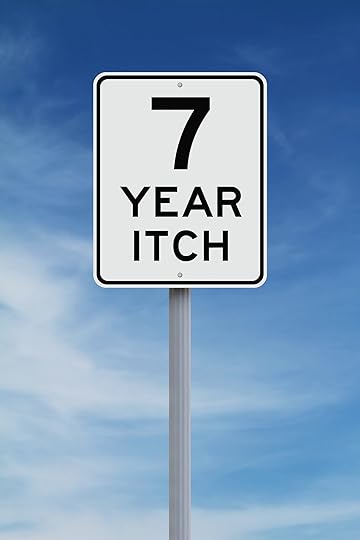
ACX as Distributor
This article focuses on using ACX as your distributor since it is the most widely known and utilized site.
Many RHs find a Royalty Share (RS) contract with the narrator on ACX.com to be very attractive because they can get an audiobook made without incurring up-front costs. They often don’t consider that this kind of contract marries the narrator’s payment to the distribution agreement.
Narrators are reluctant to accept an RS contract because the narrator shoulders ALL of the risk for low or no sales. Narrators look for several conditions to mitigate their risk.
A narrator is much more willing to accept the ACX hybrid contract known as Royalty Share Plus (RS+). In addition to the equal royalty split, the RH pays the narrator an amount up-front to help offset the narrator’s immediate expenses. The amount is negotiated by the RH and narrator and can be a set fee but is usually priced per finished hour (PFH).
With either an RS or RS+ contract, you are forced to accept exclusive distribution, meaning your audiobook will only be sold on Audible, Amazon, and Apple Books for the initial distribution term of 7 years. You have no option to upload your audiobook to other sites for wide distribution or sell it on CD or from your web site.
As I’ve previously written, indie authors get frustrated with the RS option for a number of reasons, especially when they itch to be relieved of the 7-year distribution term.
Contract Language
You have 2 contracts in place: the Book Posting Agreement between you and Audible, and the Production Standard Terms between you, Audible, and the narrator.
The distribution language is contained in the ACX Book Posting Agreement.
Sections 5A and 5B on exclusive or non-exclusive distribution set the initial distribution term at 7 years and include this auto-renewal clause:
After the Initial Term [7 years], this Agreement will renew automatically for additional 1 year terms (each, a “Renewal Term”) unless either party provides written notice of termination to the other party at least 60 days prior to the end of the Initial Term or the then-current Renewal Term.
Section 13B about changing the distribution to non-exclusive states:
If you elect to pay the Producer who produces an Audiobook using the ACX royalty share option, you must grant Audible exclusive distribution rights to the Audiobook and you cannot change your grant to non-exclusive.
In Section 14, the RH agrees that Audible will pay the royalties to producers on an RS contract.
Section 5-1 of the Production Standard Terms discusses the royalty payments.
Suppose you decide to use an RS or RS+ contract. Can you cancel distribution before the end of the initial 7 years?
If you want to cancel the distribution before the end of the 7 years, you must obtain the narrator’s permission to dissolve an RS or RS+ contract. Almost certainly, the narrator rightfully will demand a termination fee at that point. While section 8B of the Book Posting Agreement specifies termination fees prior to the completion of production, the contracts are silent about the termination fee once the book is on sale.
You and the narrator therefore will need to negotiate the kill fee. Remember, the narrator is expecting to earn at least their PFH rate through the royalties. If the audiobook’s sales have surpassed the total of what the PFH rate would have been, the narrator may reasonably propose a kill fee that also includes the loss of expected royalties.
What happens after the contract finishes its initial 7-year distribution term?
As you saw above, Audible’s contract language says exclusive RS agreements can’t be changed. The only way the RH can remove the narrator from the RS agreement is for them to terminate distribution with Audible, as confirmed in this section of the Contracts and Agreements Qs and As page:
Can I change my contract from Exclusive to Non-exclusive?
Changing the distribution rights to your audiobook depends on the payment option you have chosen. If the audiobook was completed as a pay-for-production deal, the distribution rights can be changed from exclusive to non-exclusive after it has been live in the store for one year. If this audiobook is in a royalty share deal, then the agreement can never be changed. For more information, please reference section 12.a. of the Book Posting Agreement.”
I’ve had a number of RS books I narrated pulled by the RH after the 7-year initial distribution term because they wanted to terminate the RS contract. The big downside to this approach is that the RH not only loses the income and visibility of the book being on Audible, but all of the ratings and reviews the book earned during the 7 years are gone, too.
At the point the RH terminates the RS contract, he then may republish the audiobook since he owns the copyright to the recording, and the producer has assigned all interest in the book to the RH, as explicitly stated in Section 10 of the Production Standard Terms:
Ownership. Subject to the restriction on audiobook production rights above and the distribution rights granted by Rights Holder to Audible, Rights Holder will retain all right, title, and interest in and to the Book and the Audiobook, including the copyright in the Book and the sound recording copyright in the Audiobook. Producer agrees that the Audiobook is a “work made for hire” to the full extent permitted by law, with all copyrights in the Audiobook owned by Rights Holder. To the extent that the Audiobook does not qualify as a work made for hire under applicable law, Producer assigns to Rights Holder all right, title and interest Producer may have in and to the Audiobook, including, but not limited to, all copyright or rights of authorship in the Audiobook. Producer will ensure that its agreements with any third parties Producer engages to assist in the production of the Audiobook establish Rights Holder’s sole ownership in the Audiobook. Producer will use the form agreements referenced in Section 2 above. At Rights Holder’s request, Producer will provide Rights Holder with copies of the agreements.
Be aware that ACX and Audible will not send the audio files to you. You would need to download them from your ACX Dashboard. Go to Completed Projects, select the book, choose Produce Audiobook tab, and download each file by pressing Download on the right side.
The cure for the ACX 7-year itch is available to you at the BEGINNING of the project: decide to pay the narrator per finished hour (PFH) instead of using an RS or RS+ contract.
When you pay a PFH rate at the outset, you can select non-exclusive distribution on ACX and then immediately distribute your audiobook to other platforms, including those that offer your audiobook to libraries. You also have the option of exclusive distribution for the first year and then changing to non-exclusive distribution as early as year two.
If you’d like to discuss distribution options, including royalty rates, I’m available for 30- or 60-minute paid consultations, which can be booked through the “Rent My Brain” link on my Shop page.
The post Cure For The ACX 7-Year Itch appeared first on Karen Commins.
April 16, 2020
Breaking a Contract on ACX
March 19, 2020
Avoid Copyright Infringement During The Pandemic (and Always)
I first saw someone on Facebook propose a concept. A day or so later, I read a tweet from another person writing about the same thing. Suddenly, it seemed that this idea started spreading exponentially. I began to worry about narrator friends who were unnecessarily exposing themselves to risk.
You see, due to the closures and social distancing measures prompted by the COVID-19 pandemic, many audiobook narrators, teachers, and parents have announced plans to record books on YouTube to educate and entertain children or even the public at large. They don’t realize they could be liable for copyright infringement.
Before I finished grad school with my Master of Science in computer information systems, I considered switching to law school to specialize in intellectual property law. I therefore was beyond excited to be accepted in the 2020 CopyrightX course offered by Harvard Law School.
I’ve learned so much in this course and look forward to my successful conclusion of it in early May.
While I’m not a copyright expert, I want to share some information to help these well-intentioned people better understand the laws so that they can avoid the possibility of copyright infringement during the pandemic and thereafter.
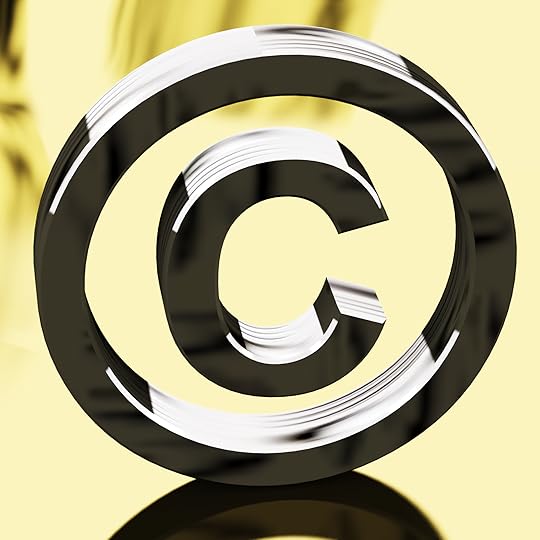
Copyright Basics
First, you should know that the copyright owner has exclusive rights in 4 areas:
The right to reproduce their work as a copy
The right to create or approve derivative works based on the copyrighted work
The right to control distribution of the work
The right to control public performances or displays of the work
Audiobooks are a derivative work. Audiobook publishers and producers pay the copyright owner to license the rights to produce and distribute a sound recording of the book’s text for a specified period of time.
Those who have not licensed the book but record it anyway are infringing on the copyright.
Those who simply perform the book live on YouTube, Instagram, or elsewhere but haven’t licensed the rights to create and distribute a derivative work or publicly perform it are infringing on the copyright.
You could think that the copyright holder “probably won’t mind” if you read their book aloud on a public YouTube channel. Some people might rationalize this argument something like this: “We’re in the middle of a global pandemic. Think of the children!”
I contend the copyright holders probably WILL mind a great deal. If they allow the infringement for this situation, they’re effectively telling a court that they don’t value the protection of their creative work. If they do nothing now but later sue someone for a different infringement, I think their argument is weakened after taking no action today.
One defense often used in copyright infringement cases is Fair Use. This standard allows people to use copyrighted materials for certain purposes such as news reporting and criticism. However, this defense is a subjective, slippery slope because courts weigh 4 factors, quoted from the US Copyright Office:
The purpose and character of your use
The nature of the copyrighted work
The amount and substantiality of the portion used in relation to the copyrighted work as a whole
Effect of the use upon the potential market for or value of the copyrighted work
In general, courts seem more tolerant of an infringement for a non-profit educational effort. However, Fair Use most likely would not be a winning argument for the type of project where people perform the complete copyrighted book over the internet to a potentially unlimited audience.
Audible Captions Case
Although the situation is different and involves a commercial enterprise, the recent Audible Captions case perfectly demonstrates these principles.
Audible announced in the summer of 2019 that listeners could generate “captions” in the Audible app while listening to an audiobook. Artificial intelligence created a transcription from the audio that produced the text from the book. Audible explained that users would be able to see a definition for a word, look up Wikipedia entries, or translate it to another language.
Audible had a license only to distribute the audiobooks.
Audible had not licensed the rights to reproduce and distribute the actual text from the book. The big 5 publishers plus Chronicle and Scholastic immediately filed suit for copyright infringement. The publishers firmly stated in their complaint that Audible was “taking copyrighted works and repurposing them for its own benefit without permission” and ‘unlawfully creating derivative works of, reproducing, distributing, and publicly displaying unauthorized copies of the Works.”
In its reply to the publishers, Audible noted that it was guided by “a desire to promote learning and listener engagement.” The document discusses Audible’s plan to provide 150,000 students and teachers with free Audible accounts with access to a small, curated library. They would continue to pay royalties on the audiobooks in the program, and users would have to opt-in to get the captions on a particular book. Audible cited numerous cases in efforts to support their position that they could display the text.
Audible also claimed a Fair Use defense since the Captions would help listeners better understand the material. Again, they cited numerous cases and listed examples of “profound potential benefits for listeners of all ages and styles.”
The judge didn’t buy anything that Audible was selling. She issued an injunction stating Audible is “permanently restrained, enjoined, and prohibited from creating, generating, reproducing, modifying, distributing, publishing, or displaying, without express authorization from the owners or exclusive licensees of the United States digital text rights, written text derived from the audiobook versions of Publishers’ Works for any product or service created or offered by Audible. This prohibition does not apply to any text in the public domain.” Audible and the publishers negotiated a settlement agreement in which Audible had to pay an unspecified amount to each of the 7 publishers who filed the complaint.
The Audible Captions case clearly shows that the purpose, intention and circumstances behind copyright infringement don’t excuse its illegality. Copyright owners fiercely protect their work, and the law is on their side.
Options
Let’s look at the options open to those who want to do online readings.
Books Still Under Copyright
This Cornell University chart shows the copyright terms and dates works enter the public domain within the US. The terms and dates are different in other countries. If the book is still protected by copyright, determine if the publisher has already granted permission for this type of usage. You may need to contact the publisher.
Penguin Random House has created an Open License to cover the US this situation. This license requires an unlisted YouTube channel and reporting about usage.
Little, Brown Young Readers, an imprint of Hachette, permits this type of usage as long as you meet the requirements .
I tweeted to Hachette, HarperCollins, Macmillan, and Simon & Schuster to ask if they have created a license similar to Penguin Random House. I’ll update this page as I learn more information.
Public Domain
A book falls into the public domain when the copyright has expired. Works in the public domain belong to all of us and can be used for any purpose including public performance without any reporting requirements or royalty payments owed to anyone.
In the US, any book published in or before 1924 is in the public domain. Each 1 January, the next year’s books will join the public domain. For instance, on 1/1/2021, books published in 1925 become public domain material.
Books published between 1925 and 1963 require research to determine their copyright status. Books published from 1964 to present are almost assuredly still under copyright.
Some wonderful Public Domain books for children can be found at these sites:
The Public Domain Sherpa site lists over a dozen sites, including this collection of “Literature for Children”
UCLA Children’s Book Collection
Public Domain Review children’s books
Baldwin Library of Historical Children’s Literature at the University of Florida
Creative Commons
Some authors decide they want to give up some or all of their copyright protection and have adopted a Creative Commons license for it. This organization offers 6 licensing options that give people permission to do certain things with the original work. All Creative Commons licenses require attribution, and some do have restrictions. If you’re planning an online performance, you need to be careful to choose a work that allows you to “remix” and “redistribute”.
In searching for texts with Creative Commons licenses, I mostly found sites offering only images. Authors may not know about this kind of license or may be opposed to using it. However, I discovered you can find some children’s books published with Creative Commons licenses such as these example sites:
Brothers Whim
Wikimedia Commons scanned children’s books
Original Material
Of course, if you write your own story, you are free to read it online and/or record it because you own the copyright.
In writing this article, I don’t mean to extinguish the burning flames of anyone’s desire to assist others. I’m simply doing my part — from a distance! — to help people stay safe in these difficult times.
The post Avoid Copyright Infringement During The Pandemic (and Always) appeared first on Karen Commins.
January 6, 2020
Plan Your Work and Work Your Plan
I’ve always been a planner. I’ve even planned vacations more than a year out so that the trip would coincide with a certain date, like when I decided we’d be on cruise ship sailing through the Panama Canal on my birthday. A friend asked me about my plans for this year and expressed curiosity about my planning process, which inspired me to write this article.

Background
First, it may help to know that I love the book Write It Down, Make It Happen: Knowing What You Want and Getting It. The author relates numerous stories about various, interesting ways people wrote about an idea as the first step toward making their dream a reality. The act of writing changes the idea from a mere thought in your brain to an attainable goal in the real world. Many of my grand plans start out as glimmering thoughts in my journal.
I have stopped setting big yearly goals like number of books to narrate or amount of money to be earned in a year. Some of those things are beyond my control, especially in devastating years like 2017-2018. Whenever I didn’t meet my big goals, I’ve felt disappointed and critical of myself rather than celebrating all the things that I did accomplish.
In the last 3 years, I’ve adopted the idea of having a focus word guide me through the year. A 2018 article stated to choose something you want more of. “What is your life missing now? Choose that.”
Optimism was my key word for 2018. Content was doubly important as my word for 2019 as I wanted more of both the adjective for an emotional state and the noun for creative output. My word for 2020 remains my secret as I think telling it may diminish its power.
My key word helps me establish intermediate targets like contacting X publishers each month that I hope will lead to the big achievements. I also select some milestones that are completely within my control. For example, this year I will create at least 2 more video courses for NarratorsRoadmap.com. I already know the topics and am gathering the material I want to include in the courses.
Go-to Apps
Evernote and my calendars are the foundations for everything I do, both personally and professionally. When I wrote above that I’m gathering material to include in my courses, it means that I’m copying web pages, making notes, and adding media to an Evernote notebook named for the course subject.
As soon as I know I’m going to an activity or am taking a trip, I add the function on my calendar with 1 or more reminders before the day. I’ll be able to look forward to events and schedule my other activities around them. Though we’re not even a week into the new year, I’ve already scheduled trips to NY in March and May for multiple audiobook events, participation at VOAtlanta Audiobook Academy in March, and attendance at the play “Hamilton” when it tours here in Atlanta in April. When planning travel, I copy all of my confirmation emails to Evernote and fill out my Evernote trip itinerary template with all the pertinent details and links to those emails.
I use Evernote as my client relationship manager and set reminders on notes for follow-up actions. The Cronofy Evernote Calendar Connector automatically transfers the reminders to my calendar and keeps Evernote and my calendar in synch. I have a color-coded calendar to distinguish various activities.
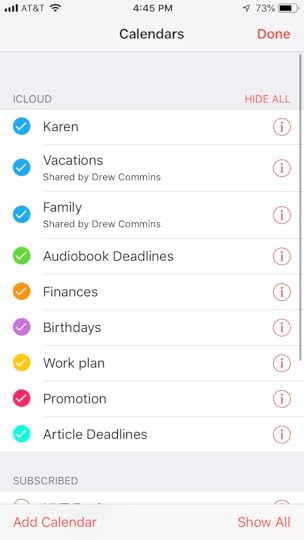
For instance, I add dates with tie-ins to specific audiobooks to my Promotions calendar. I may set the first reminder a week ahead for a new book where I want to create a graphic. I’d set the second reminder for the day before the date to be sure I schedule the promotion. Sometimes after seeing a reminder about an audiobook in my backlist, I’ll create a new graphic to promote it, such as in this recent tweet.
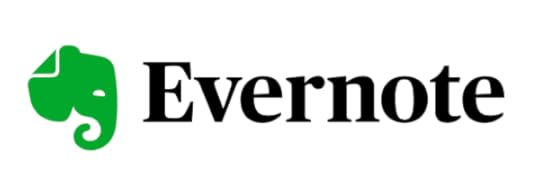
I start each month by filling in this Evernote template that I created to itemize the major things I want to get done that month. I confess that I’m notorious for trying to stuff 10 pounds of activities into a 2-pound bag! I may not do half the things I set out to do, but action begets action begets action, which all becomes and sustains forward movement. I add dates from the calendar for my standing commitments like my biweekly show for the Georgia Radio Reading Service and the Tuesday tips I write and distribute each week on Twitter.
On a daily basis, I look at the monthly note and my list of Evernote reminders and then fill in this Evernote template of 1 to 5 things I expect to do that day. I list personal appointments like the dentist and hair salon among those 5 tasks.
In the blank space at the top of the note, I record the audio of my daily sightreading practice and enter info about exercise I undertook that day like swimming and walking the dog. Throughout the day, I check the boxes when completing tasks and add any links or documents created in the process.
I have almost 2700 Daily Notes in Evernote stretching back to October 2012. Before I started keeping them in Evernote, I used paper calendars. My paper archives go back to 2003!
I love having all of my planning info in Evernote because it’s searchable, and I can add audio, pictures, videos, emoticons, and links to each page. If I don’t finish something in a day, which is OFTEN the case due to the rabbit holes I jump in, I can copy and paste it to the next day (or even the next week).
I hope that sharing part of my process gives you some useful ideas for your own planning sessions! I’d love to see your questions and comments below.
The post Plan Your Work and Work Your Plan appeared first on Karen Commins.
September 16, 2019
How I Spent My Summer Vacation
When a kid returns to school in the fall during a movie or TV show, they invariably must write and recite a report discussing how they spent their summer vacation. I never recall having that assignment at the start of any school year.
If I had, my report probably would have included the number of books I checked out from the library and the songs I learned to play on piano, and, from 5th grade on, the music I played on clarinet, oboe, and flute. I also would have talked about my daily trips to the pool.
My almost daily pool time would certainly remain present in such a chronicle today; some things never change. However, today’s account also would be bubbling with discussion about my new web site NarratorsRoadmap.com, which is fully launching today 9/16 at 9:00am!
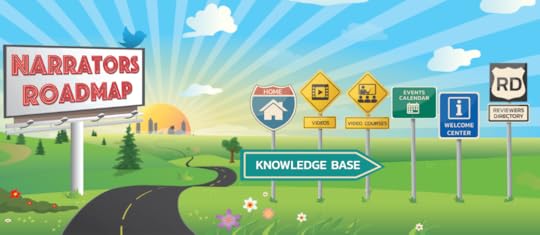
Looking back, I can connect the dots and see this site has been in my destiny for quite a while and is a natural evolution and expansion of things I’ve been doing.
When I worked my day job in IT, I planned software, hardware, and wiring purchases, installations, and upgrades and solved daily operational problems. Other network administrators asked my advice when they’d run out of options in troubleshooting difficulties like an inoperable email server. In addition to helping my peers with technical issues, I wrote software tips for the users every week for over 5 straight years.
Soon after starting my voiceover business in 1999, I created my first web site. Other people found me on-line and began asking me how to get into voiceover, so I created an advice page.
 My first advice page as seen on 10-13-2002.
My first advice page as seen on 10-13-2002.That advice page and the emails I kept receiving led me to start this blog.
Once I got back into audiobooks after ACX.com launched, I found myself answering questions from new narrators in Facebook forums. Over time, I created an extensive FAQ in one group. I’ve become well known for being the Queen of Links since I provide so many of them on-line and throughout my articles.
After noticing how positively other narrators responded to my advice, one of my mentors frequently told me that I should write a book containing all of this information. I resisted that suggestion, in part because I felt a book wouldn’t reach the right audience and would be difficult to update so that the material would remain fresh.
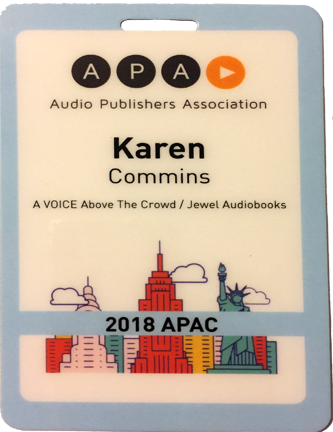
Last year at the Audio Publishers Association Conference (APAC), several events occurred in rapid succession that caused me to see so clearly that I needed to create a new web site to aid narrators!
First, I heard some narrators on a panel talking about how we all bring different things to the table and have different goals. Four comments stuck with me and may help you see the next signpost on your path:
Ask yourself throughout your career what is unique to you.
Just because there’s a gold rush going on in audiobooks doesn’t mean you need to always be the one in the creek panning for nuggets.
It’s helpful to stop thinking of yourself in the limited role of narrator.
Use what you have to get what you want.
I arrived late to lunch that day, so most of the tables were filled. The panelists’ remarks were swirling in my mind, and I thought I might find a quiet place and write about them in my journal. At that precise moment, a narrator friend intersected my path and asked to have lunch with me. (I’m convinced the Universe planned it that way.) She thanked me for all of the info in my blog articles and told me they had been a tremendous help to her. She also suggested that I write a book using my blog articles as the basis for it.
As we talked, another narrator friend stopped and asked me a question, which I was able to quickly answer. (I think the Universe sent that person across my path then, too, to drive home the point that helping narrators is part of my purpose.)
I didn’t write anything until I was waiting at the far-from-quiet-gate that evening at LaGuardia Airport. By the time I boarded the plane, I realized I needed to create a membership site! In addition to the all of the information I typically disseminate through my articles and links to other sites, I also knew that some things aren’t easily found on-line. For starters, narrators were re-inventing the wheel to discover training and networking events they could attend and bloggers who would write thoughtful reviews of their audiobooks.
In addition, experienced narrators constantly needed ready information to pass on to newcomers who asked questions about how to get started in the field. Why not create one comprehensive list of resources to answer them?
The solid idea came together that day, but I was delayed in doing much on it last summer and fall because we were house-hunting, moving, and settling in our new home.
Although I earned an MS in computer information systems and worked in technical IT positions for 25 years, I never wanted to develop my new membership site. Just because you CAN do something doesn’t mean you should! I discussed my ideas with Joe Davis at Voice Actor Websites soon after arriving home from APAC, and we started implementing my planned site toward the end of the year. I chose that company to create the site because they had done a marvelous job with this one, and I wanted continuity between the sites, both in the user interface and the WordPress construction.
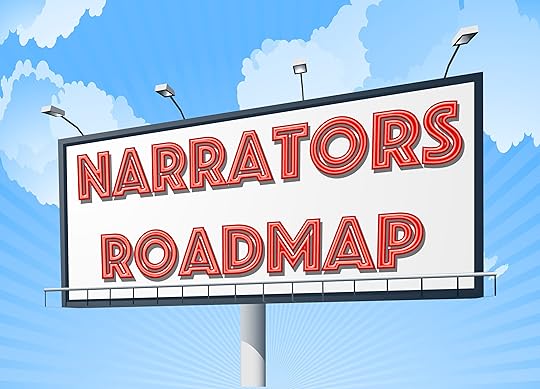
Phase 1 was a splash page that was overflowing with articles, books, videos, and links to help newcomers learn how to be a narrator. We launched it on 19 January so it would be available for people who attended the APA’s open webcast on 22 January titled What I Wish I Knew.
Phase 2 would be the roll-out of the full site. I’ve lost count of the number of Zoom meetings Drew and I had with our wonderfully responsive project manager Alex Sanchez. The VAWS team developed a gorgeous and highly functional site that exceeds my vision and expectations!
In addition to all of the design discussions with the developers, I’ve been writing articles for the Knowledge Base and creating an incredible list of helpful links on the Welcome Center page. Drew and I have researched and added to the site calendar color-coded events in 8 categories, as well as detailed information about audiobook reviewers. As you’ve probably guessed, all this work required far more time and energy than a summer vacation!
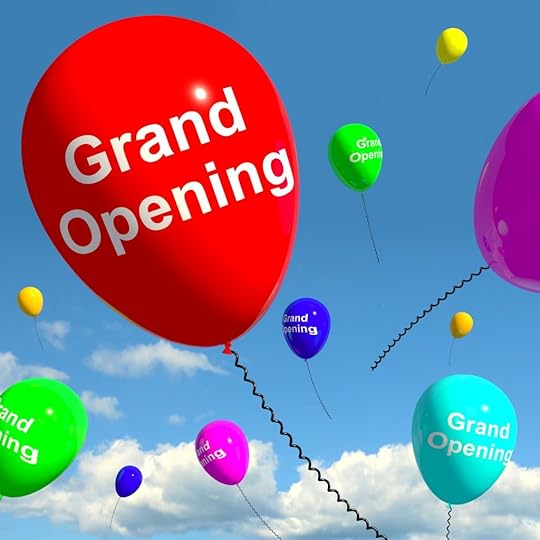
NarratorsRoadmap.com is THE destination for audiobook narrators of all levels!
I’m overjoyed that the full site is finally HERE and LAUNCHING TODAY!
The site has more links than even I thought possible — and that’s saying something!
 To celebrate the grand opening of this unique repository of goodness for narrators,
To celebrate the grand opening of this unique repository of goodness for narrators, I’m holding a CONTEST!
To participate, look through the free areas of the site (Home page, Knowledge Base, and Welcome Center) to answer these 3 questions IN A COMMENT BELOW before 11:59pm ET, Monday 23 September 2019. I’ll award 3 random winners with a 3-month Members Express Pass to the site, which gives you access to all of the calendar events and audiobook reviewer information. If you can’t find an answer, I’ll give you credit for creativity!
Questions:
What number is on the mile marker, and what is its significance?
What is the name of the song that is no longer under copyright that appears in one of the Knowledge Base articles?
What is the name of the only marketing book mentioned on the site?
Bonus question for an extra free month:
I asked the developers to include an Easter Egg, which is a special object that is significant to me. Like any Easter Egg hunt in real life, the surprise can be “hiding” in plain sight. Can you find it? I’ll even throw in a 2nd extra free month if you can tell me its significance.
Thanks so much for your interest, and good luck with your entries!
The post How I Spent My Summer Vacation appeared first on Karen Commins.



